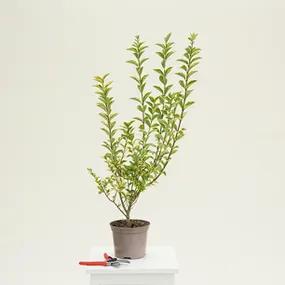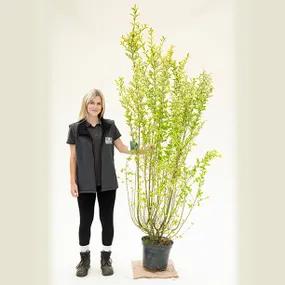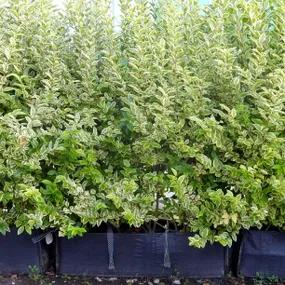Golden Privet Hedging Plants
Honest Delivery PricesLigustrum ovalifolium Aureum
Hedge Plants- Yellow / green variegated leaves.
- Excellent evergreen urban hedging.
- Suitable for poor soil & partial shade.
- Max. Height: 4m
- RHS Award of Garden Merit
- Bareroot delivery Nov-March
Recommended extras
Description
Golden Privet Hedging - Ligustrum ovalifolium Aureum
Delivered by Mail Order Direct from our Nursery with a Year Guarantee
Golden Privet Hedging, Ligustrum ovalifolium Aureum, is a variety of Privet with rich yellow variegated edges to its leaves.
It is a popular hedge plant, especially for the inner city, and it is suitable for topiary.
It every bit as tough and tolerant of poor soils as the other privets, although we recommend using green privet instead if your site is in full shade.
Golden Privet is good for hedges up to between 3-4 metres high, but can reach a full 6 metres.
Golden Privet hedge plants are delivered bareroot during winter (Nov-March).
Choosing a size:
When you are ordering Golden Privet plants for a hedge, we generally recommend that you use smaller plants. They are cheaper than large plants, easier to handle and they will establish well in poor conditions. Use larger plants if you want a taller hedge quickly, or if you want to clip them for topiary.
All our hedge plants are measured by their height in centimetres above the ground (the roots or pots aren't measured).
Spacing a Golden Privet hedge:
Plant Golden Privet hedging at 3 plants per metre, 33cm apart.
General description of Golden Privet plants:
Golden Privet is a large, vigorous bush with bright leaves that clip easily into a formal evergreen hedge. It is great for growing in trouble spots in the city. It does really well on poor or dry soils, in partial shade and it isn't affected by air pollution. It can grow in exposed sites near the sea, although constant wind will slow its growth.
If it is grown as a specimen shrub, it will produce good sized cones (called panicles) of scented white flowers in summer that attract butterflies. These will mature into shiny, bitter little fruits that are eaten by several types of songbirds.
Old privet hedges respond very well to hard pruning.
Privet can lose its leaves in harsh winters: this is normal and doesn't hurt your plants.
Did You Know?
This Japanese plant was recorded by Western botanists in 1862 and introduced to Britain soon afterwards. You may see it listed in some old books as Ligustrum ovalifolium Aureomarginatum. It has won an RHS Award of Garden Merit for handsome plants that are easy to grow.
Planting Instructions
Growing Golden Privet plants:
Golden Privet will grow well in any conditions with average soil drainage. It thrives in the poor, compacted soil that is often found in the front gardens of urban houses and it does well in partial shade. It is suitable for exposed sites (although it won't grow quite so quickly) and can grow quite close to the sea; if you are right on the coast, we recommend planting the similar looking New Zealand Privet (Griselinia) instead. Established privet plants are drought resistant.
Privet is a hardy evergreen, but please note that it does tend to lose its leaves for a couple of months in harsh winters. This is normal and doesn't damage the plants.
Privet will not grow well in soil that is too boggy.
Prepare your site before planting:
Privet is very tough. The only essential preparation is to kill the weeds in a strip a metre wide along the planting site: improving the soil should not be necessary. If your soil is exceptionally poor and dry, then digging in some well-rotted manure and/or compost is worthwhile.
Watch our video on how to plant a garden hedge for full details. The plants in this video are delivered pot-grown, but planting out bareroot stock is essentially the same.
Remember to water establishing plants during dry weather for at least a year after planting.
Hedge Planting Accessories:
Prepare your site for planting by killing the weeds and grass. You can buy a hedge planting pack with sheets of mulch fabric and pegs to hold it down.If you are planting in an area with rabbit and/or deer, you will need to use a plastic spiral guard for each plant, supported by a bamboo cane. If your soil quality is poor, we recommend using Rootgrow mycorrhizal "friendly fungi" on the roots of new trees and shrubs.
After Care
After you have planted your Golden Privet hedge, the most important thing to do is water it in dry weather. You will also need to weed around the plants. Watering should be thorough, so the ground is soaked. Let the soil almost dry out before watering again. Watering & weeding will be necessary for at least a year after planting.
Like all evergreen plants, Golden Privet is active and needs moisture in the ground throughout the year. This means that if the weather is dry, your establishing plants need to be watered in the winter when they are planted.
Trimming Formal hedge plants: Golden Privet doesn't need any clipping at all in its first year. In the winter of the year after planting, your young hedge should be trimmed lightly and then once every winter after that until it is mature. When it is fully grown, you can clip it at any time.
Special notes on caring for Golden Privet hedges:
Golden Privet is a very tough hedge plant that shouldn't need special attention once it has established. If you didn't use a mulch fabric, it is beneficial to mulch around the base of the hedge each year with well-rotted manure or compost.
Hygiene & Diseases:
Dead, damaged or diseased wood can be pruned off as soon as it appears.
Disinfect your pruning tools between every cut if there is any sign of disease.
Burn or dispose of any diseased material, do not compost it.
After you have planted your Golden Privet hedge, the most important thing to do is water it in dry weather. You will also need to weed around the plants. Watering should be thorough, so the ground is soaked. Let the soil almost dry out before watering again. Watering & weeding will be necessary for at least a year after planting.
Like all evergreen plants, Golden Privet is active and needs moisture in the ground throughout the year. This means that if the weather is dry, your establishing plants need to be watered in the winter when they are planted.
Trimming Formal hedge plants: Golden Privet doesn't need any clipping at all in its first year. In the winter of the year after planting, your young hedge should be trimmed lightly and then once every winter after that until it is mature. When it is fully grown, you can clip it at any time.
Special notes on caring for Golden Privet hedges:
Golden Privet is a very tough hedge plant that shouldn't need special attention once it has established. If you didn't use a mulch fabric, it is beneficial to mulch around the base of the hedge each year with well-rotted manure or compost.
Hygiene & Diseases:
Dead, damaged or diseased wood can be pruned off as soon as it appears.
Disinfect your pruning tools between every cut if there is any sign of disease.
Burn or dispose of any diseased material, do not compost it.

 1.webp)
 1.webp)
 2.webp)



